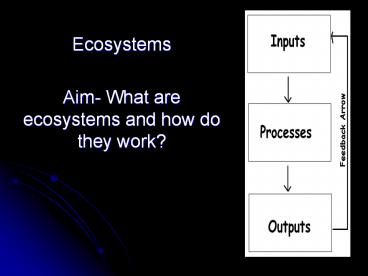Ecosystems - PowerPoint PPT Presentation
1 / 25
Title: Ecosystems
1
- Ecosystems
- Aim- What are ecosystems and how do they work?
2
(No Transcript)
3
What are ecosystems and how do they work?
- The picture on the left is an ecosystem, showing
all living things and non-living things
4
What is an ecosystem?
- An ecosystem is a community of interacting plants
and animals. An ecosystem is made up of two
components - Living things and
- Their non-living environment eg water, air, rocks
and soil
5
Ecosystems
6
What are ecosystems and how do they work?
- Did you know?
- insects, birds and fish are all animals
- grass and trees are plants
- mushrooms are fungi a special type of plant
Task 2 Explain (relate cause and effect) if the
following are ecosystems, explain your answer in
detail a) b) c)
7
How do ecosystems work?
- The living things interact with their environment
and each other
How big are ecosystems? They can exist at a
variety of scales local, regional and national
- An ecosystem is any size you choose to study, for
example, - a pond - a forest
- a desert - an ocean
8
Feeding in an ecosystem.
- Did you know?
- a few plants can feed on
- Insects
- they trap the insect in a bowl of liquid that
just dissolves them away
- It all starts with the suns energy transfer to
plants - Plants trap suns energy in chlorophyll
- Carbon dioxide is taken in as is water through
roots - It uses the suns energy to turn these into
glucose (sugar) this process is called
photosynthesis - It combines this glucose with minerals from the
soil to make the things it needs to grow
9
A food chain
- A food chain is the relationship between living
organisms where one organism is dependent on
another as a source of food.
10
What happens next?
CONSUMERS
PRODUCERS
a caterpillar
which is eaten by.
which is eaten by.
is eaten by
a wood mouse
the leaf
a fox
dead remains, droppings and other waste material
. are eaten by .
earthworms, insects, fungi and bacteria
DECOMPOSERS
11
A Food Chain shows which creatures eat each other
In this example, grass is eaten by cows, which
are eaten by people
12
Interactives
- http//www.crickweb.co.uk/assets/resources/flash.p
hp?filefoodchains Food Chains - http//www.zephyrus.co.uk/foodpuzzlechain.html
Food Chains - http//ecokids.earthday.ca/pub/eco_info/topics/fro
gs/chain_reaction/assets/flash/chain_reaction.swf
Flash interactive - http//puzzling.caret.cam.ac.uk/game.php?gamefood
chain Food Chain game
13
Primary producers
- Plants are the primary producers in an ecosystem
because they produce their own food.
14
Primary Secondary Consumers
- Herbivores are primary consumers as they eat
plants. Herbivores are eaten by the secondary
consumers carnivores (meat eaters). Some animals
eat a mixture of plants and animals these are
known as omnivores.
15
Decomposers
- Decomposers include many types of bacteria and
fungi. Their function is to break down the wood,
dead leaves and dead bodies of other living
things so that every living thing is recycled.
16
Grass is the PRODUCER
Cows are Primary Consumers as they eat the grass,
they are called HERBIVORES
Humans are secondary consumers eating the cow,
when humans eat both animals and plants they are
called OMINIVORES
Animals which eat other animals only are called
CARNIVORES
17
Food Web
- A food web is the series of interconnected food
chains within an ecosystem.
18
Energy flows
- Each ecosystem is sustained by the flow of energy
through it. The main source of energy is
sunlight. - Energy is then able to pass through the ecosystem
in a food chain in which plants are eaten by
animals, and some animals consume each other. In
other words, each link in the chain feeds on and
obtains energy from the link preceding it. In
turn it is consumed by and provides energy for
the link that follows it. - Flash animation http//www.mhhe.com/biosci/esp/200
1_gbio/folder_structure/ec/m3/s2/ecm3s2_6.htm
19
Recycling of nutrients
- Each cycle consists of plants taking up nutrients
from the soil. The nutrients are then used by
plants, or by animals which consume the plants.
When the plants or animals die, they decompose
and the nutrients are released and returned to
the soil ready for future use.
20
Nutrient Cycle
21
SUMMARY
An Ecosystem is the relationship between Soil,
Climate, Vegetation and Animals in an environment
22
SUMMARY
Ecosystems recycle nutrients, such as Carbon
Nitrogen
PROCESSES Feeding Reproduction Decomposition
INPUTS Sunlight Air Rain Soil
OUTPUTS Oxygen Water Minerals
23
Extension task
- All ecosystems depend on the sun Do you agree?
- Draw a diagram to help you explain your answer.
24
Homework
- The earth is the largest ecosystem of all.
Illustrate how (you choose drawing or writing)
humans fit in to this ecosystem? - Tips to help
- What do humans do to the worlds ecosystem?
- How do humans manage the worlds ecosystem?
- How do humans control the worlds ecosystem?
25
Nutrient Cycle































